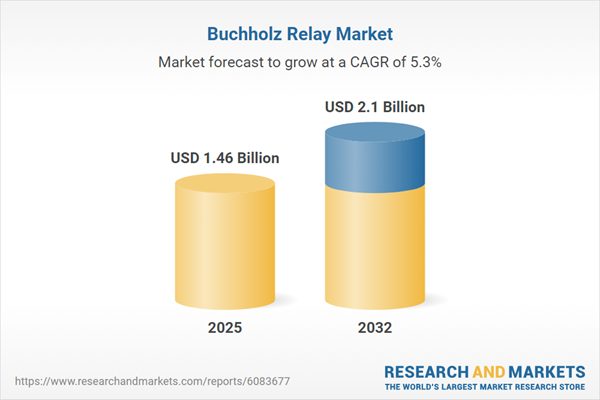Speak directly to the analyst to clarify any post sales queries you may have.
As power infrastructure evolves, the Buchholz Relay Market stands at the forefront of reliable transformer protection. Senior decision-makers face critical choices in a sector shaped by technology upgrades, regulatory evolution, and global supply chain shifts.
Buchholz Relay Market Snapshot
The Buchholz Relay Market grew from USD 1.39 billion in 2024 to USD 1.46 billion in 2025. It is projected to continue its upward trajectory at a CAGR of 5.32%, ultimately reaching USD 2.10 billion by 2032. This sustained expansion reflects both increased demand for transformer resilience and the growing complexity of energy infrastructure worldwide. Key drivers include the integration of digital monitoring capabilities, adoption of decentralized grid models, and investments to modernize legacy power systems.
Scope & Segmentation
- Type: Float Actuated, Merz-Price
- End Use: Commercial, Industrial, Power Utilities
- Distribution Channel: Aftermarket, Original Equipment Manufacturer
- Transformer Type: Gas-Insulated, Oil-Immersed
- Voltage Rating: Extra High Voltage, High Voltage, Low Voltage, Medium Voltage
- Regions: Americas (including United States, Canada, Mexico, Brazil, Argentina, Chile, Colombia, Peru), Europe, Middle East & Africa (including United Kingdom, Germany, France, Russia, Italy, Spain, Netherlands, Sweden, Poland, Switzerland, United Arab Emirates, Saudi Arabia, Qatar, Turkey, Israel, South Africa, Nigeria, Egypt, Kenya), and Asia-Pacific (including China, India, Japan, Australia, South Korea, Indonesia, Thailand, Malaysia, Singapore, Taiwan)
- Leading Companies: ABB Ltd., Siemens Aktiengesellschaft, Schneider Electric SE, General Electric Company, Mitsubishi Electric Corporation, Eaton Corporation plc, Toshiba Corporation, Schweitzer Engineering Laboratories, Inc., Omicron Electronics GmbH & Co. KG, Megger Group Limited
Buchholz Relay Market: Key Takeaways
- Technological advancements are transforming the Buchholz relay from a strictly mechanical safety device into an integral component of smart transformer ecosystems.
- Manufacturers are prioritizing sensor integration and modular product designs to enable easier upgrades, higher reliability, and faster maintenance.
- Stringent regulatory standards and updated testing protocols are pushing the industry toward enhanced detection accuracy, data analytics capability, and digital interoperability.
- Growing decarbonization targets and distributed generation trends are spurring development of relays compatible with new grid configurations and variable power flows.
- End users in power utilities, heavy industry, and commercial sectors increasingly prefer solutions that offer asset condition monitoring and predictive maintenance features.
- Adaptable portfolios that address differing voltage classes and transformer types are essential for meeting region-specific requirements and unlocking market potential worldwide.
Tariff Impact and Supply Chain Dynamics
The 2025 introduction of targeted import tariffs in the United States has notably impacted cost structures, particularly for specialized relay components sourced internationally. Producers are mitigating this through localized manufacturing, regional supplier diversification, and strategic partnerships to maintain competitive pricing and ensure reliable availability. These actions have also led to deeper vendor collaboration, more flexible logistics, and increased focus on just-in-time deliveries. For customers, evolving supply models have prompted a reevaluation of total cost of ownership and have expanded the adoption of value-added service offerings, like extended warranties and integrated maintenance.
Performance by Segment and Technology
Distinct relay variants address diverse needs: Float Actuated devices support cost-sensitive standard transformer protection, while Merz-Price models target advanced fault sensitivity. Commercial deployments leverage compact, easily maintained designs, while industrial users demand rugged, high-durability options. For transformer types, Gas-Insulated units require relays with specialized sealing, while Oil-Immersed setups favor ease of inspection. High and Extra High Voltage systems require relays engineered for rapid response and enhanced dielectrics, while lower voltages benefit from compact housings and simpler calibration.
Regional Trends and Regulatory Drivers
North and Latin America focus on retrofitting and grid modernization, driven by stringent regulations and renewable energy investments. The EMEA region sees Europe emphasizing certification and smart relay adoption, the Middle East pursuing infrastructure expansion, and Sub-Saharan Africa prioritizing maintenance and reliability. Asia-Pacific stands out for rapid infrastructure growth, electrification, and extensive use of modular, sensor-integrated relays, reflecting the diversity and dynamism of the Buchholz relay market globally.
Methodology & Data Sources
This report relies on a multi-pronged research approach, integrating interviews with sector experts and stakeholders, systematic secondary analysis of technical manuals and regulatory documents, and data triangulation techniques to validate findings. Quality assurance measures and expert reviews support the reliability of all conclusions presented.
Why This Report Matters
- Empowers executives with actionable direction for product development, regulatory compliance, and partnership strategies in fast-evolving safety relay markets.
- Provides a comprehensive breakdown of market dynamics, supply chain risks, and competitive positioning across regions and applications.
- Supports informed capital allocation by illustrating technology trends, emerging adoption patterns, and evolving customer requirements.
Conclusion
The Buchholz Relay Market is being reshaped by technology, global policy shifts, and diverse application requirements. Senior leaders equipped with this insight can confidently shape product, sourcing, and go-to-market strategies to drive success in an increasingly complex landscape.
Table of Contents
3. Executive Summary
4. Market Overview
7. Cumulative Impact of Artificial Intelligence 2025
Companies Mentioned
The companies profiled in this Buchholz Relay market report include:- ABB Ltd.
- Siemens Aktiengesellschaft
- Schneider Electric SE
- General Electric Company
- Mitsubishi Electric Corporation
- Eaton Corporation plc
- Toshiba Corporation
- Schweitzer Engineering Laboratories, Inc.
- Omicron Electronics GmbH & Co. KG
- Megger Group Limited
Table Information
| Report Attribute | Details |
|---|---|
| No. of Pages | 197 |
| Published | November 2025 |
| Forecast Period | 2025 - 2032 |
| Estimated Market Value ( USD | $ 1.46 Billion |
| Forecasted Market Value ( USD | $ 2.1 Billion |
| Compound Annual Growth Rate | 5.3% |
| Regions Covered | Global |
| No. of Companies Mentioned | 11 |









